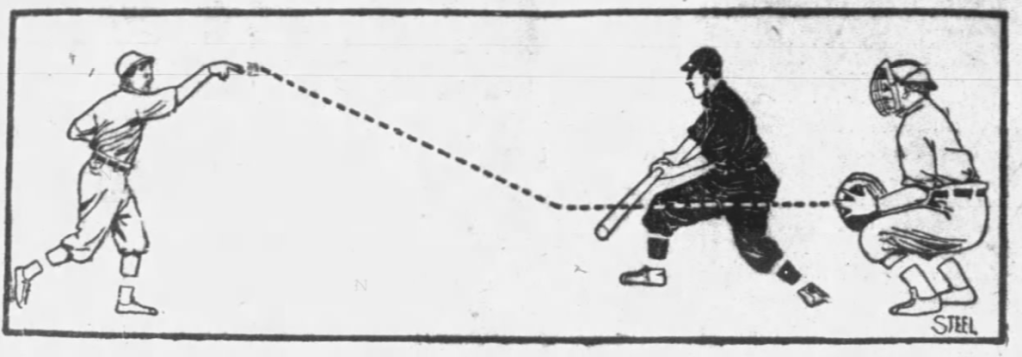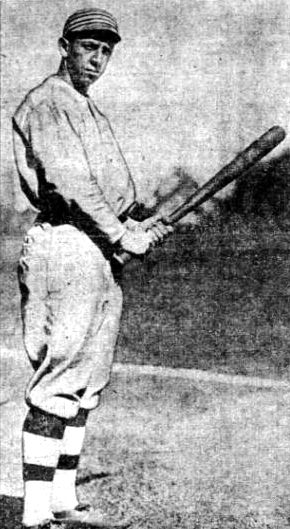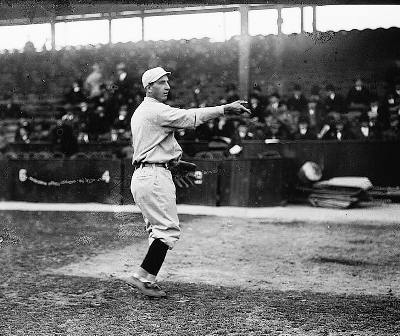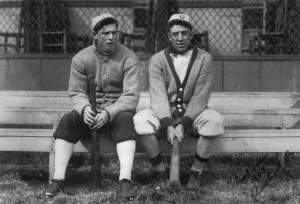In December of 1917, thirty-eight-year-old sportswriter Grantland Rice of The New York Tribune enlisted in the army–he spent fourteen months in Europe. Before he left he laid out the case, over two weeks, for an all-time all-star team in the pages of the paper:
“As we expect to be held to a restricted output very shortly, due to the exigencies and demands of the artillery game, this seemed to be a fairly fitting period to unfold the results.”
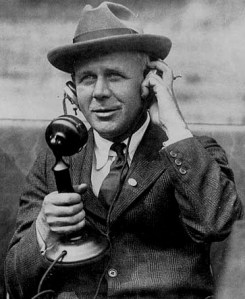
Grantland Rice
Rice said the selections were “not solely from our own limited observation, extending over a period of some eighteen or twenty years,” but included input from players, managers and sportswriters, including “such veterans” as Frank Bancroft and Clark Griffith, and baseball writers Joe Vila of The New York Sun, Bill Hanna of The New York Herald and Sam Crane, the former major league infielder turned sportswriter of The New York Journal.
Rice said only one of the nine selections “(S)eems to rest in doubt. The others were almost unanimously backed.”
The selections:
Pitcher: Christy Mathewson
“A. G. Spalding, John (Montgomery) Ward, Larry Corcoran, Charley Radbourn, John Clarkson, (Thomas) Toad Ramsey, Tim Keefe, Bill Hoffer, Amos Rusie, (Mordecai) Miner Brown, Addie Joss, Ed Walsh–the array is almost endless.
“In the matter of physical stamina, Cy Young has outclassed the field. Cy won more games than almost any others ever pitched.
“(But) For all the pitching mixtures and ingredients, stamina, steadiness, brilliancy, brains, control, speed, curves, coolness, courage, is generally agreed that no man has ever yet surpassed Christy Mathewson…there has never been another who had more brains or as fine control.”
[…]
“It might be argued that Radbourn or (Walter) Johnson or (Grover Cleveland) Alexander was a greater pitcher than Mathewson.
But we’ll string with Matty against the field.”
Radbourn was the second choice. Bancroft said:
“Radbourn was more like Mathewson than any pitcher I ever saw. I mean by that, that like Matty, he depended largely upon brains and courage and control, like Matty he had fine speed and the rest of it. Radbourn was a great pitcher, the best of the old school beyond any doubt.”
Catcher: William “Buck” Ewing
“Here we come to a long array—Frank (Silver) Flint, Charley Bennett, (Charles “Chief”) Zimmer, (James “Deacon”) McGuire, (Wilbert) Robinson, (Marty) Bergen, (Johnny) Kling, (Roger) Bresnahan and various others.
“But the bulk of the votes went to Buck Ewing.”
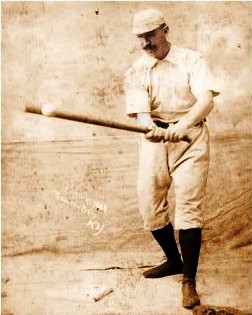
Buck Ewing
[…]
“Wherein did Ewing excel?
“He was a great mechanical catcher. He had a wonderful arm and no man was surer of the bat…he had a keen brain, uncanny judgment, and those who worked with him say that he had no rival at diagnosing the weakness of opposing batsman, or at handling his pitchers with rare skill.”
Kling was the second choice:
“Kling was fairly close…a fine thrower, hard hitter, and brilliant strategist…But as brilliant as Kling was over a span of years, we found no one who placed him over the immortal Buck.”
1B Fred Tenney
First Base was the one position with “the greatest difference of opinion,” among Rice and the others:
“From Charlie Comiskey to George Sisler is a long gap—and in that gap it seems that no one man has ever risen to undisputed heights… There are logical arguments to be offered that Hal Chase or Frank Chance should displace Fred Tenney at first.
But in the way of batting and fielding records Tenney wins….Of the present array, George Sisler is the one who has the best chance of replacing Tenney.”
2B Eddie Collins
“There was no great argument about second base.
“The vote was almost unanimous.
“From the days of Ross Barnes, a great hitter and a good second baseman on through 1917, the game has known many stars. But for all-around ability the game has known but one Eddie Collins.”
Rice said the competition was between Collins, Napoleon Lajoie and Johnny Evers:
“Of these Lajoie was the greatest hitter and most graceful workman.
“Of these Evers was the greatest fighter and the more eternally mentally alert.
“But for batting and base running, fielding skill, speed and the entire combination, Collins was voted on top.”
SS Honus Wagner
“Here, with possibly one exception, is the easiest pick of the lot. The game has been replete with star shortstops with George Wright in 1875 to (Walter “Rabbit”) Maranville, (George “Buck”) Weaver…There were (Jack) Glasscock and (John Montgomery) Ward, (Hardy) Richards0n, (Hugh) Jennings, (Herman)Long, (Joe) Tinker and (Jack) Barry.
“But there has been only one Hans Wagner.”

Honus Wagner
Jennings and Long were rated second and third, “But, with the entire list considered there is no question but that Wagner stands at the top.”
3B Jimmy Collins
Rice said:
“From the days of (Ned) Williamson, (Jerry) Denny, and (Ezra) Sutton, over thirty years ago, great third basemen have only appeared at widely separated intervals.
“There have been fewer great third basemen in baseball than at any other position, for there have been periods when five or six years would pass without an undoubted star.”
The final decision came down to “John McGraw vs. Jimmy Collins.” McGraw was “a great hitter, a fine bunter and a star base runner,” while “Collins was a marvel and a marvel over a long stretch…he was good enough to carve out a .330 or a .340 clip (and) when it came to infield play at third he certainly had no superior…So taking his combined fielding and batting ability against that of McGraw and Collins wins the place. McGraw was a trifle his superior on the attack. But as a fielder there was no great comparison, Collins leading by a number of strides.”
OF Ty Cobb
“The supply here is overwhelming…Yet the remarkable part is that when we offered our selection to a jury of old players, managers and veteran scribes there was hardly a dissenting vote.”
[…]
“Number one answers itself. A man who can lead the league nine years in succession at bat.
“A man who can lead his league at bat in ten out of eleven seasons.
“A man who can run up the record for base hits and runs scored in a year—also runs driven in.
“Well, the name Ty Cobb answers the rest of it.”
OF Tris Speaker
“The man who gives Cobb the hardest battle is Tris Speaker. Veteran observers like Clark Griffith all say that Speaker is the greatest defensive outfielder baseball has ever exploited…Speaker can cover more ground before a ball is pitched than any man. And if he guesses incorrectly, which he seldom does, he can go a mile to retrieve his error in judgment…And to this impressive defensive strength must be added the fact he is a powerful hitter, not only a normal .350 man, but one who can tear the hide off the ball for extra bases.”

Tris Speaker
OF “Wee Willie” Keeler
“Mike Kelly and Joe Kelley—Jimmy Sheckard and Fred Clarke—the slugging (Ed) Delehanty—the rare Bill Lange—Billy Hamilton.
“The remaining list is a great one, but how can Wee Willie Keeler be put aside?
“Ask Joe Kelley, or John McGraw, or others who played with Keeler and who remember his work.
“Keeler was one of the most scientific batsmen that ever chopped a timely single over third or first…And Keeler was also a great defensive outfielder, a fine ground coverer—a great thrower—a star in every department of play.
“Mike Kelly was a marvel, more of an all-around sensation, but those who watched the work of both figure Keeler on top.”
Rice said of the nine selections:
“The above is the verdict arrived at after discussions with managers, players and writers who have seen a big section of the long parade, and who are therefore able to compare the stars of today with the best men of forgotten years.
“Out of the thousands of fine players who have made up the roll call of the game since 1870 it would seem impossible to pick nine men and award them the olive wreath. In several instances the margin among three or four is slight.
“But as far a s deductions, observations, records and opinions go, the cast named isn’t very far away from an all-time all-star round up, picked for ability, stamina, brains, aggressiveness and team value.
“If it doesn’t stick, just what name from above could you drop?”
Tags: A. G. Spalding, Addie Joss, Amos Rusie, Bill Hanna, Bill Hoffer, Bill Lange, Billy Hamilton, Buck Ewing, Buck Weaver, Charlie Bennett, Charlie Comiskey, Chief Zimmer, Christy Mathewson, Clark Griffith, Cy Young, Deacon McGuire, Ed Delehanty, Ed Walsh, Eddie Collins, Ezra Sutton, Frank Bancroft, Frank Chance, Fred Clarke, Fred Tenney, George Sisler, Grantland Rice, Grover Cleveland Alexander, Hal Chase, Hardy Richardson, Herman Long, Honus Wagner, Hughie Jennings, Jack Barry, Jack Glasscock, Jerry Denny, Jimmy Collins, Jimmy Sheckard, Joe Kelley, Joe Tinker, Joe Vila, John Clarkson, John McGraw, John Montgomery Ward, Johnny Evers, Johnny Kling, Larry Corcoran, Marty Bergen, Mike "King" Kelly, Mordecai Brown, Napoleon Lajoie, Old Hoss Radbourn, Rabbit Maranville, Roger Bresnahan, Ross Barnes, Sam Crane, Silver Flint, Tim Keefe, Toad Ramsey, Tris Speaker, Ty Cobb, Walter Johnson, Wee Willie Keeler, Wilbert Robinson

